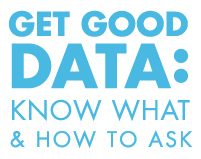Don’t Be a Jerk When Gathering Website Visitor Data
03.12.14 · Ashley Bowen Cook
It’s tempting, we know. You have a website and want to collect that oh-so-juicy visitor information to further your marketing efforts. But how you ask for that information makes all the difference. You can be honest and courteous, or you can be … that person. The guy who takes the last piece of pizza without asking. The one who insists you help him move a refrigerator up three flights of stairs. The fact is, if you use bad manners to get information from your website visitors, it will backfire. Your visitors will be left with a bad taste in their mouths, which can affect future interactions with your company. Knowing what’s appropriate and what isn’t is the key to getting the data you want without alienating your audience. The following scenarios are examples of things you’ll want to avoid.
 1. Don’t blindside.
1. Don’t blindside.
You’re visiting a website when you see a link that says, “Sign our card and we’ll donate to needy orphans.” You, as a caring individual, click the link. You’re then asked to log into Facebook. Although you weren’t expecting it, lots of sites ask you to log into Facebook these days, so you’re not concerned. But then you see a pop-up box that says that the site will have access to all your data, your friend’s data, your pet’s data, your high-school transcript, etc. Now you’re concerned.
2. Don’t bait and switch.
This starts out with something like, “Fill out our short survey for a chance to win.” And then after you click you’re inundated with page after page of personal questions, usually with no way to gauge how much more you have to fill out before you’re actually finished. The more questions you fill out, the more frustrated you become.
3. Don’t be a pest.
A box pops up the second you land on a website saying, “We appreciate your feedback. Please fill out our survey.” While you appreciate the politeness of saying “please,” you’re not interested and you close the pop-up so you can get back to what you were doing. You go to another page and are treated to the exact same pop-up. You dismiss it. It comes back again. Over. And. Over. You fear that the website will eventually scream, “I will not be ignored!” and attack your loved ones. 
Miss Manners Data-gathering Guide
Despite the examples above, it’s possible to successfully gather information from your visitors without harming your relationship with them in the process. Let the practices below serve as your etiquette guide as you think about what kinds of information you’d like to gather from your website visitors.
1. Ask only for what you absolutely need.
Visitors are stingy with their information, and asking too much can be off-putting. If you have a newsletter sign-up form on your site, only ask for the visitor’s email address and his or her name. You take this approach because website visitors will only fill in as much information as they think the payoff justifies. In addition, because most other sites only require a small amount of information for newsletter sign-up forms, visitors expect it to be that way for all websites. Another reason to restrict what you ask is that as the amount of required information increases, the level of confidence the visitor has in you decreases. Asking too much may result in visitors assuming something shady is going on, especially if the kinds of information you’re asking for seem unnecessary.
2. Ask for information in stages.
Many websites use outrageously long forms in the mistaken belief that the only way to get information is all at once. A better approach is to gather the data from shorter forms and storing that information in a cookie on the visitor’s browser. This allows you to add to the information as the visitor continues to interact with your site, even across multiple visits to the site. Using this technique builds a more complete profile of the visitor without being obtrusive.
 3. Be courteous.
3. Be courteous.
Your visitors give their information freely, and should be treated with respect. If a visitor declines to give you information, don’t press the point by repeatedly asking through pop-ups or other means. Be honest in how much you’re going to require from visitors. If your site includes a survey, explain how long the survey will take before they even click the link to take the survey. If the survey spans multiple pages, let the visitor know how many total pages there are and what page they’re currently on. These simple additions will greatly increase the likelihood that the entire survey will be filled out. And finally, make sure you have a privacy policy that clearly spells out what types of information you gather from your visitors and why. This transparency builds confidence with your customers.
Adjust Your Approach
Meeting the needs of your website visitors while achieving your own goals can be a balancing act. Even if done in the most pleasant manner possible, asking for too much information too often can cause your audience to prematurely leave your site. And while they might not complain to you directly, their unhappiness may show up in your website analytics. If you’re seeing pages that have a high rate of abandonment, it’s a good indication that your visitors are leaving that page for a particular reason. And if that reason is your approach to information gathering, it’s something you can easily fix.
* This article was originally published in the March 13 issue of BlueSky Business Aviation News.
